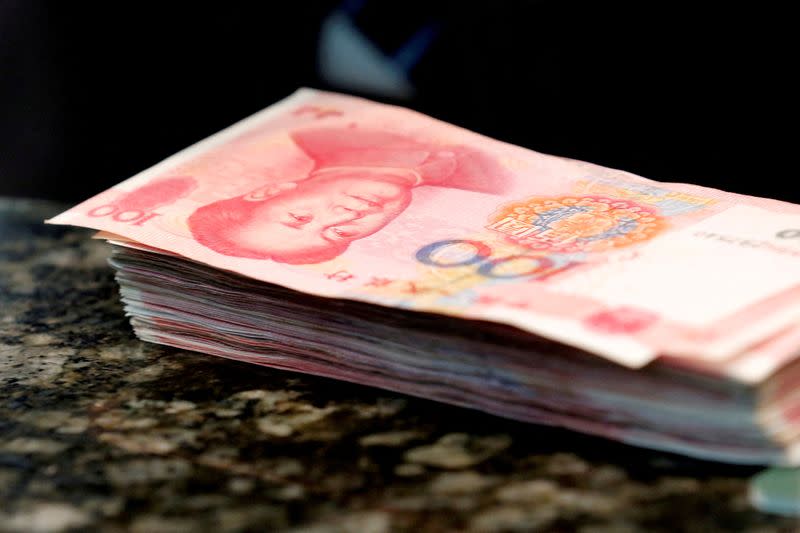The Chinese yuan hit a six-month low this week and many analysts and business people expect the currency to weaken further this year.
Bond markets are putting Chinese and global rates on opposite paths, speculating on cuts in China to boost the country’s faltering recovery, compared to possible hikes by the US Fed to tame inflation.
That has prompted banks and Chinese companies to prepare for a weaker currency as Beijing rolls out more stimulus.
The yuan fell past the closely-watched seven-per-dollar level last month and hasn’t stopped, as China’s post-pandemic economic recovery slumps amid weak demand at home and abroad.
ALSO SEE:
US Set to Rejoin UNESCO in Move to Bolster Tech Influence
Yuan ‘set to remain pressured’: JP Morgan
Surprise cuts to key China rates dragged the yuan lower this week, putting the gap between 10-year sovereign yields in China and the US at its widest since November. The gap with British yields is the widest in 16 years.
The position, with China’s rates below those in the United States, is the reverse of more than a decade of high-growth that saw China paying better yields than markets in the west.
That it is failing to unwind as the pandemic recedes has caught many off-guard and – along with the speed of the yuan’s recent slide – has investment banks cutting currency forecasts and analysts seeing risks ahead as companies hoard dollars.
“(The yuan) is set to remain pressured by structurally negative carry that handicaps supportive flows including foreign portfolio investment bond inflows and corporate dollar selling,” JP Morgan analysts said in a note.
“The People’s Bank of China’s tolerance of currency weakness … also opens up room for further yuan weakness.”
JP Morgan recently downgraded its year-end yuan forecast, from 6.85 per dollar to 7.25 per dollar.
Yuan could touch 7.3 per dollar this year
The yuan has lost nearly 4% so far this year to 7.1674 per dollar on Wednesday, making it one of the worst performing Asian currencies, as China’s widely touted post-Covid recovery quickly lost steam.
Some investment banks expect the yuan to end the year as weak as 7.3 – a level seen in November when China’s borders were shut and strict health policies disrupted economic activity.
That would imply a further 1.8% depreciation.
The People’s Bank of China did not immediately respond to a request for comments on banks’ cuts to yuan forecasts or risks to the currency from corporates’ positioning.
Further easing seen in China
Policy action and expectations are driving the rates and currency markets to move in tandem in anticipation that western economies will continue to struggle to rein in inflation and keep policy settings tight, while China will be struggling to replicate its pre-pandemic growth.
Even if the Federal Reserve holds rates steady later on Wednesday, as expected, traders are braced for an extended period of elevated US interest rates and, increasingly, for China to hold rates low or push them even lower.
This week China cut its reverse repo rate and another short-term cash rate for commercial banks, seen as a signal that further policy easing is in the offing. Analysts polled by Reuters expect the PBOC will cut the costs of medium-term loans on Thursday and many market watchers expect a benchmark lending rate cut next week.
Authorities have also been guiding state-owned banks to cut interest rates on dollar deposits, according to sources with direct knowledge of the matter, in an effort to nudge exporters to shift their huge and growing pile of dollars back into yuan.
Chinese companies have accumulated $24.2 billion of “excess” dollar savings over the past year, according to a JP Morgan estimate, bringing the total foreign exchange deposits in China to $851.8 billion at end of May.
To be sure, moving even some of that into yuan ought to be supportive, and the forwards market implies traders are much less bearish than the bank forecasts.
“A lower dollar deposit rate will act as a counter-cyclical measure,” said Tommy Xie, head of Greater China research at OCBC Bank, and discourage borrowing in yuan to buy dollars.
However, traders and analysts said companies are unlikely to follow the authorities’ intended path and may even direct their capital outside China to offshore accounts.
The SOFR, a benchmark overnight dollar interest rate, traded at 5.05% on Wednesday, 75 basis points higher than the ceiling of dollar deposit rates at big banks in China, showing dollars can earn better interest abroad.
“Corporates may be increasingly attracted to putting their dollar proceeds in offshore accounts,” Kiyong Seong, lead Asia macro strategist at Societe Generale, said.
“Capital outflow was a clear risk factor to depreciate the yuan further in the second half of this year,” he said, with lowered dollar deposit rates presenting such a risk.
- Reuters with addtional editing by Jim Pollard
ALSO SEE:
China’s Exports Sink by 7.5% in May Amid Global Slowdown
US ‘to Extend’ China Chip Curb Waivers for South Korea, Taiwan
Firms Backing China’s PLA Pilots, Missiles Hit in US Crackdown
China’s Property Sector Will Remain Weak For Years: Goldman
China Manufacturing Slips Further in May, as Recovery Falters
























